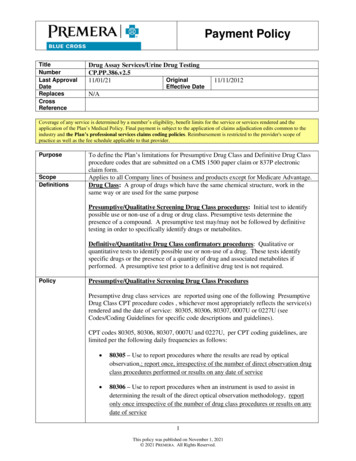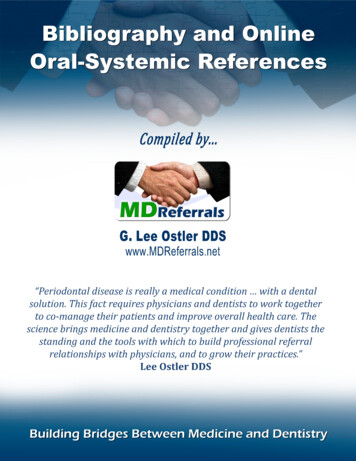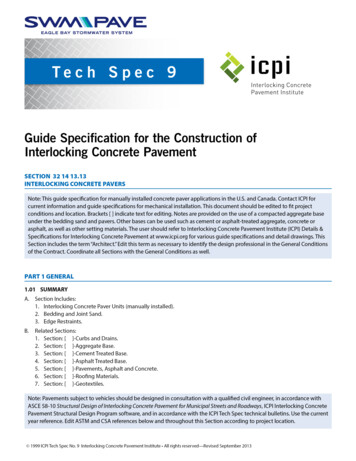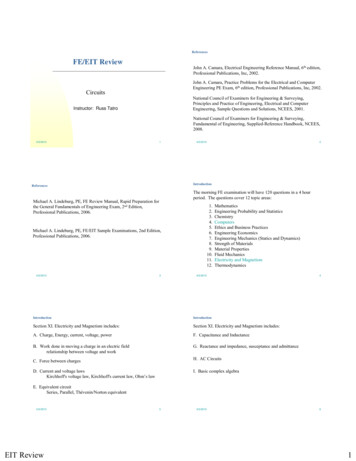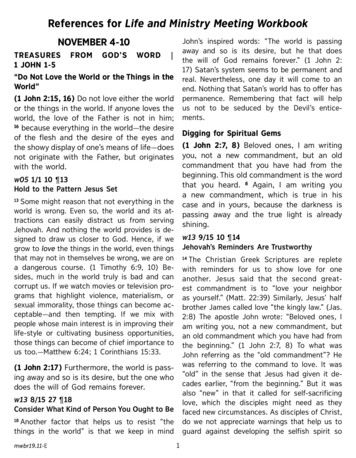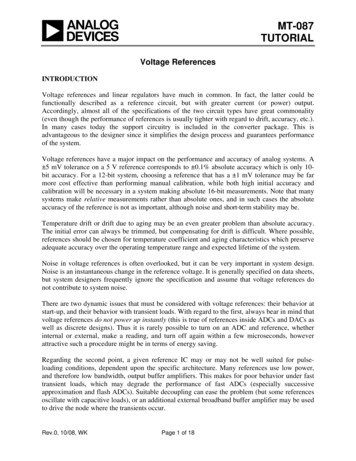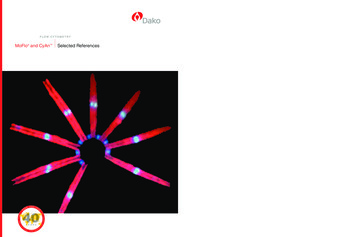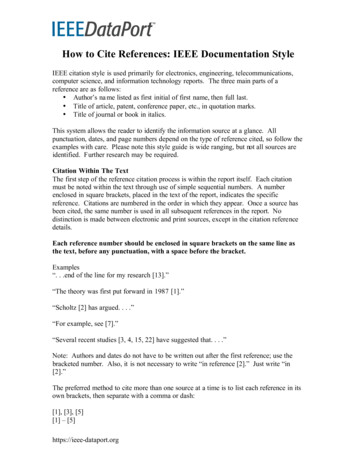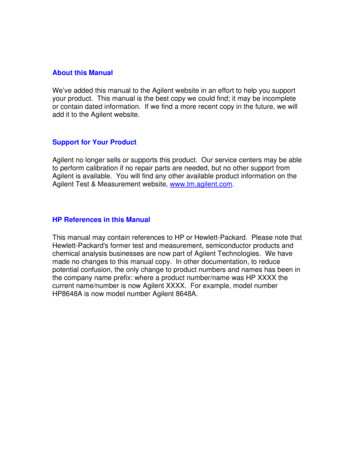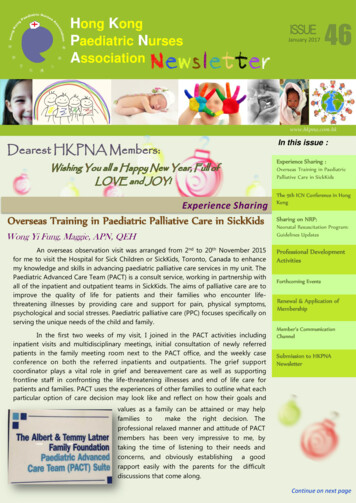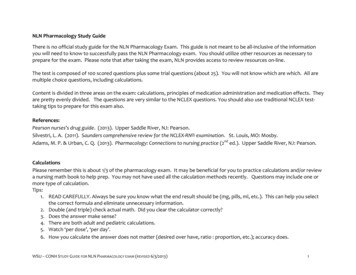
Transcription
NLN Pharmacology Study GuideThere is no official study guide for the NLN Pharmacology Exam. This guide is not meant to be all-inclusive of the informationyou will need to know to successfully pass the NLN Pharmacology exam. You should utilize other resources as necessary toprepare for the exam. Please note that after taking the exam, NLN provides access to review resources on-line.The test is composed of 100 scored questions plus some trial questions (about 25). You will not know which are which. All aremultiple choice questions, including calculations.Content is divided in three areas on the exam: calculations, principles of medication administration and medication effects. Theyare pretty evenly divided. The questions are very similar to the NCLEX questions. You should also use traditional NCLEX testtaking tips to prepare for this exam also.References:Pearson nurses’s drug guide. (2013). Upper Saddle River, NJ: Pearson.Silvestri, L. A. (2011). Saunders comprehensive review for the NCLEX-RN examination. St. Louis, MO: Mosby.Adams, M. P. & Urban, C. Q. (2013). Pharmacology: Connections to nursing practice (2nd ed.). Upper Saddle River, NJ: Pearson.CalculationsPlease remember this is about 1/3 of the pharmacology exam. It may be beneficial for you to practice calculations and/or reviewa nursing math book to help prep. You may not have used all the calculation methods recently. Questions may include one ormore type of calculation.Tips:1. READ CAREFULLY. Always be sure you know what the end result should be (mg, pills, ml, etc.). This can help you selectthe correct formula and eliminate unnecessary information.2. Double (and triple) check actual math. Did you clear the calculator correctly?3. Does the answer make sense?4. There are both adult and pediatric calculations.5. Watch ‘per dose’, ‘per day’.6. How you calculate the answer does not matter (desired over have, ratio : proportion, etc.); accuracy does.WSU – CONH STUDY GUIDE FOR NLN PHARMACOLOGY EXAM (REVISED 6/3/2013)1
2Common calculations include (but are not limited to):1. Kg to mg to mcg conversion (any which way)LKHDMDCMmcgGliter(kilo – hecto – deca – meter – deci – centi – milli – skip – skip – micro)gram2. Dosage calculationsa. Tabletsb. mg. to tabletsc. mg. to mld. units to mle. kg to mlf. Half-life calculationg. IV rate calculation (hourly infusion rate) AND adjustmenth. IV rate dosage calculation (based on units per ml, etc.)i. Macro- vs. micro-drop tubingj. Calculating drops/minute (gtts/min)Examples: (abbreviated to type of question; exam will add extra information)1. Have 5 mg tablets; ordered dose 2.5 mg. How many tablets will the nurse administer?2. Have 2 mg/2 ml; order is 1 mg. How many milliliters will the nurse administer?3. Prepare a 20 mEq dose of a medication. Available solution is 40 mEq/10 ml. How many ml will be administered?Note: calculation method is not different in examples 1 - 3, just the unit of measure (mg, units, mEq, etc.). BE SURE AVAILABLEAND HAVE ARE THE SAME UNIT OF MEASURE.4. Half-life conversion: Half-life is known to be 2 hours. What percentage will be left in the body after six hours?5. A person weighs 165 lbs. How many kg does the person weigh?WSU – CONH STUDY GUIDE FOR NLN PHARMACOLOGY EXAM (REVISED 6/3/2013)2
6. The available medication has been reconstituted to 250 mg/5 ml. The order is 5 mg/kg/daily in two evenly divided doses.Child weight 44 pounds. How many milliliters will be administered per dose? NOTE: More than one calculation methodmust be used to answer this question.7. IV was ordered at 1000 ml over 8 hour period. After two hours, only 900 ml has infused. Calculate the new infusion ratefor the medication to be administered within the original 8 hour period.8. Order is for 3000 cc over a 24-hour period. What is the hourly flow rate? OR: What will the pump be set at per hour?9. Order is for antibiotic to be mixed in 50 ml NS and administered over 45 minutes. What is the hourly flow rate? OR:What will the pump be set at per hour?10. Volume is 1000 ml. Ordered infusion time is 8 hours. Have tubing of 15 drops/ml. How many drops need to be counted todeliver the identified milliliters per minute?11. Available solution 25,000 units in 250 ml NS. Order is to administer at 22 ml/hour. How many units will be given perhour?12. Available solution 25,000 units in 250 ml NS. Administer at 2000 units/hour. How many ml will be given be hour? OR:What will the pump be set at per hour?Principles of PharmacologyThese include the basics! Review:1. Routes of administration – benefits and problems2. Sizes of needles and syringes for injections3. Six Rights of Medication Administration; Three Checks4. Side effects; adverse effects; paradoxical reactions; toxicity; antagonists5. Half-life calculation6. Allergic or hypersensitivity reactions7. Absorption, metabolism, distribution and excretion8. There may be questions on lab values as relevant.9. There are pediatric and adult questions.10. Immunosuppression precautions (due to meds for cancer, HIV/AIDS, etc.)WSU – CONH STUDY GUIDE FOR NLN PHARMACOLOGY EXAM (REVISED 6/3/2013)3
Administration routes: some key pointsSublingual administration absorbed in mucosa of oral cavities rapid onset of action Place tablet on floor of mouth, close mouth. Do not swallow, hold under tongue until dissolve. Use spray on floor of mouth under tongue and close mouth.Buccal place tablet between gum and cheek near back of mouth, close mouth and keep in place until dissolve slower to dissolve and absorb than sublingualIntramuscular injections Given in the vastus lateralis in children up to 3 Spread skin taught to bring muscle near surface of skin, with dart-like motion insert needle at 90 degrees Aspirate to determine if needle enter a blood vessel. If there is blood return discard the needle and meds and startprocedure over.NGtube / Gtube NG usually temporary; G-tube for longer term Follow instructions re crushing, dissolving medication – no sustained release medsEye drop administration Clean exudates from eye; (2) tilt head toward side of affected eye; (3) pull lower eyelid down; (4) have pt. look up; (5)instill drops in conjunctival sac formed by lower lid (not onto the eye); (6) Apply gentle pressure for 30 sec to 1 min overinner cantus next to nose (this prevents absorption through the tear duct and drainage of the medication). Close eyesgently massage the eyes to distribute the meds. Slow absorption except in infants where they readily absorbEYE OINTMENT Same as eye drop except it is expressed directly into the conjunctival sac from the inner canthus to the outer canthus. Closeeyes and gently massage to distribute the medicationWSU – CONH STUDY GUIDE FOR NLN PHARMACOLOGY EXAM (REVISED 6/3/2013)4
Definitions:Agranulocytosis / Neutropenia / agranulocytopenia Definition: Acute decrease in the number of granulocytes/leukopenia (WBC) in peripheral blood Causes include: treatment with broad spectrum PCN, sulfonamides or cephalosporin (piperacillin, tazobactam, cetazidime,ticarcillin, gentamycin), bone marrow transplant, chemotherapy, radiation. Generally is impaired resulting from bone marrow depression by drugs and chemicals or replacement by a neoplasm(orallesion, ulcer necrotic, gingivitis, buccal mucosa Lymphadenopathy, lymphadenitis may be prevalent. Could lead to respiratory infection, ulceration of mouth colon, high fever, UTI. But may be asymptomaticChelating agents A form of detoxification Chelating therapy involves an injection or oral administration of ethylene diamine Tetra acetic avide (a synthetic amino acidwhich attaches to toxic substance such as lead, cadmium, aluminum and other metal in the blood to facilitate their removalfrom the body.) May be used to treat hardening of the arteries, heart attack, stroke, arthritis and gangrene because of its ability to removeexcess calcium from the body.EDTA: Ethylenediaminetetraacetic acid Use in children with lead level between 45&70 micron/dl. EDTA binds to lead in blood and excreted by the bowel and kidney. EDTA may be toxic to kidney. Monitor urine output. Give this by IV. Dose depends on weight of child, severity of the poison. Agent is given every 4 hours for 5 days. A secondcourse may be needed if there is a rebound in the blood level. Give oral and IV fluid to enhance excretion Do not use EDTA with hypocalcemia or hypokalemia.OTHER AGENTS British antiLewisite (BAL) does not give with iron supplement and avoid in pt. with plant allergy. Give this by IM Succimer (Chemer) Chemet – oral medication - Do not give in pt. with encephalopathyEpistaxis Nose bleed. Can be anterior or posterior. Posterior is more serious. due to rupture of blood vessels within richly perfuse nasal mucosa spontaneous or initiated by trauma blood can come up through the eye, can also flow down the stomach causing nausea, vomitingWSU – CONH STUDY GUIDE FOR NLN PHARMACOLOGY EXAM (REVISED 6/3/2013)5
Treat epistaxis cauterization with silver nitrate, calcium alginate mesh, nasal cavity packed with sterile dressing ribbon gauze, absorbentdressing or saline sprayed into the nose Ice pack to forehead or back of the neck pinch septum of nose for 5 minutes Do not pack nose with tissue or gauzeHalf-life The time it takes for a medication to lose half of its pharmacologic or physiologic effect To calculate half-life: There is a formula but the easiest way to decrease count. Example: half- life is 1 hour.Start 100%1 hr.50%2 hrs. 25%3 hrs. 12.5%4 hrs.6.25%Question – Half-life of ‘xyz’ medication is 1 hour. After 3 hours, what percentage of the medication will be left? A 12.5%Osmotic agent - see entry under MannitolParadoxical reaction A response to a drug (or medical treatment) that is the opposite to the usual response, such as agitation produced in anindividual patient by a drug which is ordered to sedate or calm a person.Sustained release / time released / extended release / controlled release Pills or capsule formulated to dissolve slowly and release drug over time. They can often be taken less frequently, keep steadier levels of the drug in the bloodstream Contain in a matrix of insoluble substance (e.g. Acrylics) the drug swells up to form a gel so that the drug has first to dissolvein matrix then exit through the outer surface. Cannot be crushed, dissolved or openedWSU – CONH STUDY GUIDE FOR NLN PHARMACOLOGY EXAM (REVISED 6/3/2013)6
Medication EffectsThere is a bit of an overlap here with Principles of Pharmacology. These questions tend to be medication (or classification)specific. There are many medications on the test and many could be. As applicable, both brand and generic names are used.We recognize the attached grid is very lengthy, but have included some of the key components as identified below. Mostmedications addressed are either high usage or high risk. Please note that auto-corrections will change generic names tostarting with caps. In the grid, we have tried to list generic first, then brand names.Areas to know:1. Use, dose, side effects, contraindications2. Since there are a limited number of questions, not all medications are addressed. You may be asked to select whichmedication would be given for a particular diagnosis. When studying, focus on the classifications – this may enable youto answer without knowing the actual medication.3. Focus on what are the major side effects of a medication or class? What makes it high risk? Why might one particularmed be used other than another?4. Patient teaching is a major focus. What would you tell the patient about the medication? What would indicateunderstanding? What would indicate need for further teaching?Common classification of medicationsNote letters in medication name and look for those letters that identify a particular classification: Androgens: end with –terone: testosterone (Testoderm) ACE Inhibitors: end with –pril: enalapril (Vasotec) Antidiuretic hormones: end with –pressin: desmopressin (DDAVP) Antilipidemic: end with –statin: atorvastatin (Lipitor) Antiviral: contain -vir: ritonavir (Norvir)WSU – CONH STUDY GUIDE FOR NLN PHARMACOLOGY EXAM (REVISED 6/3/2013)7
Benzodiazepines: include alprazolam (Xanax), chlordiazepoxide (Librium), clorazepate (Tranxene),estazolam (ProSom), and triazolam (Halcion). Most others end with –pam: diazepam (Valium) Beta Blockers: end with –lol: atenolol (Tenormin) CCB: end with –pine: amlodipine (Norvasc); some exceptions include diltiazem (Cardizem), verapamil(Isoptin) Carbonic anhydrase inhibitors: end with –mide: acetazolamide (Diamox) Estrogens: contain est: conjugated estrogen (Premarin) Glucocorticoids and corticosteroids: end with –sone: prednisone (Deltasone) Histamine H2 receptor antagonists: end with –dine: cimetidine (Tagamet) Nitrates: contain nitr: nitroglycerin (Nitrostat) Pancreatic enzyme replacements: contain pancre: pancrelipase (Pancrease) Phenothiazines: end with –zine: chlorpromazine (Thorazine) Proton Pump Inhibitors: end with –zole: lansoprazole (Prevacid) Sulfonamides: include –sulf: sulfasalazine (Azulfidine) Thiazide diuretics: end with –zide: hydrochlorothiazide (HydroDIURIL) Thrombolytics: end with -ase: alteplase (Activase) Thyroid hormones: contain –thy: levothyroxine (Synthroid) Xanthine bronchodialators: end with –line: theophyllineWSU – CONH STUDY GUIDE FOR NLN PHARMACOLOGY EXAM (REVISED 6/3/2013)8
Specific Diseases or treatments:Aminoglycoside antibiotics - Treats serious life threatening gram negative (and some positive) infectionsAll aminoglycoside ends Mycin but not all drugs that ends in Mycin are aminoglycosides such as (Erythromycin andazithromycin)Examples: Gentamycin Tobramycin Vancomycin Neomycin Generally IM or IV. Oral route is not recommended. It is only use for bowel prep prior to surgery (see Neomycin)Adverse effects/toxicity:Two most common MAJOR adverse effects: Nephrotoxicity and ototoxicity.Also: Photosensitivity risk for superinfections Pseudomembranous
You should also use traditional NCLEX test-taking tips to prepare for this exam also. References: Pearson nurses’s drug guide. (2013). Upper Saddle River, NJ: Pearson. Silvestri, L. A. (2011). Saunders comprehensive review for the NCLEX-RN examination. St. Louis, MO: Mosby. Adams, M. P. & Urban, C. Q. (2013). Pharmacology: Connections to nursing practice (2nd ed.). Upper Saddle River, NJ .
